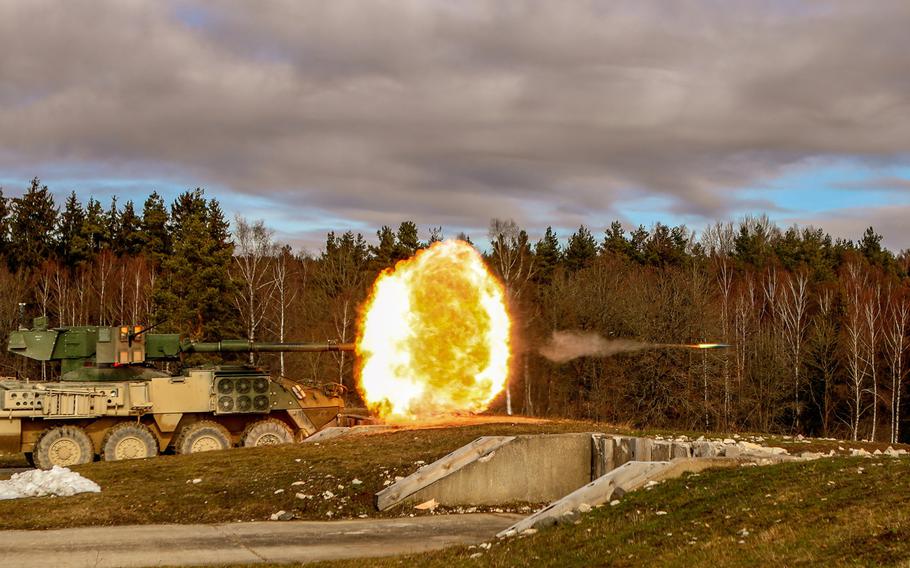
A U.S. Army Stryker Mobile Gun System variant belonging to the 4th Squadron, 2nd Cavalry Regiment, fires at targets during a weeklong gunnery exercise at the Grafenwoehr Training Area, Germany, Feb. 14, 2019. The Army will divest itself of the Stryker variant by October 2022 to free up money for more modern systems with better protection, officials said Wednesday. (Timothy Hamlin/U.S. Army)
STUTTGART, Germany — The Army is eliminating the Stryker Mobile Gun System, a vehicle that played a large role during the wars in Iraq and Afghanistan but proved vulnerable to roadside bomb attacks by insurgents.
The Army will divest itself of the Stryker variant by October 2022 in a move focused on freeing up money for more modern systems.
“This decision comes after a comprehensive analysis highlighted obsolescence and systemic issues with the system’s dated cannon and automatic loader,” the Army said.
Various other Stryker platforms, including the Double V-Hull, will continue to be supported, the Army said.
The Stryker Mobile Gun System was developed in the early 2000s with what the Army at the time deemed state-of-the-art technology. The system enabled Stryker brigades to support infantrymen by destroying or suppressing hardened enemy bunkers and sniper positions in urban combat zones.
It also was the first Army system fielded with an autoloader, which the Army said became costly to maintain over time. The Stryker MGS was based on a flat-bottom chassis that “was never upgraded against more modern threats such as improvised explosive devices or anti-tank mines,” the Army said.
In recent years, the Army has upgraded Stryker systems with more powerful weapons systems designed partly in response to concerns about a more aggressive Russia.
In April, the Germany-based 5th Battalion, 4th Air Defense Artillery Regiment was the first to field a new mobile air defense system that helps defend against threats while soldiers are on the move. The unit will use the Maneuver Short Range Air Defense system, known as M-SHORAD, mounted on its Stryker A1 vehicles.
The system will “defend maneuvering forces against unmanned aircraft systems, rotary-wing and fixed-wing threats,” the Army said in a statement.
Given concerns about the Stryker MGS vulnerabilities, Army officials decided it was time to invest in other modernization efforts to improve the rest of its Stryker fleet.
“Decisions on when it is best to divest a system currently in the force are not taken lightly,” Lt. Gen. James F. Pasquarette, Army deputy chief of staff for programs, said in a statement. “The Army has done its due diligence to ensure lethality upgrades will remain intact to provide our Stryker formations the capabilities they need in the future.”
vandiver.john@stripes.com Twitter: @john_vandiver